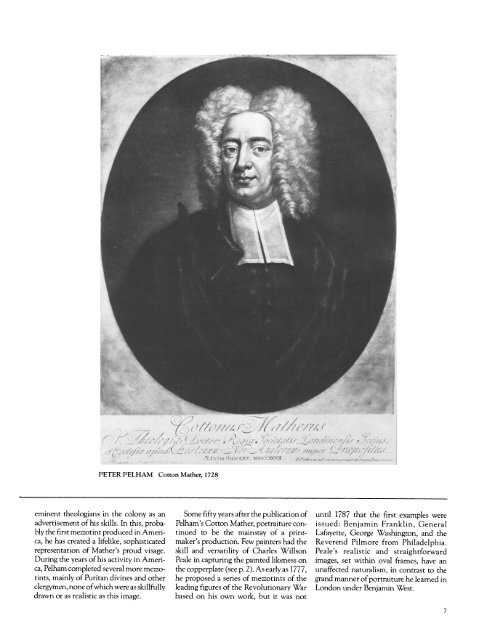The Metropolitan Museum of Art Bulletin, v. 37, no. 4
The Metropolitan Museum of Art Bulletin, v. 37, no. 4
The Metropolitan Museum of Art Bulletin, v. 37, no. 4
Create successful ePaper yourself
Turn your PDF publications into a flip-book with our unique Google optimized e-Paper software.
a lisiS xy,MDCi<br />
'<br />
PETER PELHAM Cotton Mather, 1728<br />
^ "*5 +.^^- ^.^ ,4; :^&s ". - ** -;; *. ''<br />
eminent theologians in the colony as an<br />
advertisement <strong>of</strong> his skills. In this, probably<br />
the first mezzotint produced in America,<br />
he has created a lifelike, sophisticated<br />
representation <strong>of</strong> Mather's proud visage.<br />
During the years <strong>of</strong> his activity in America,<br />
Pelham completed several more mezzotints,<br />
mainly <strong>of</strong> Puritan divines and other<br />
Some fifty years after the publication <strong>of</strong><br />
Pelham's Cotton Mather, portraiture continued<br />
to be the mainstay <strong>of</strong> a printmaker's<br />
production. Few painters had the<br />
skill and versatility <strong>of</strong> Charles Willson<br />
Peale in capturing the painted likeness on<br />
the copperplate (see p. 2). As early as 1777,<br />
he proposed a series <strong>of</strong> mezzotints <strong>of</strong> the<br />
until 1787 that the first examples were<br />
issued: Benjamin Franklin, General<br />
Lafayette, George Washington, and the<br />
Reverend Pilmore from Philadelphia.<br />
Peale's realistic and straightforward<br />
images, set within oval frames, have an<br />
unaffected naturalism, in contrast to the<br />
grand manner <strong>of</strong> portraiture he learned in

















